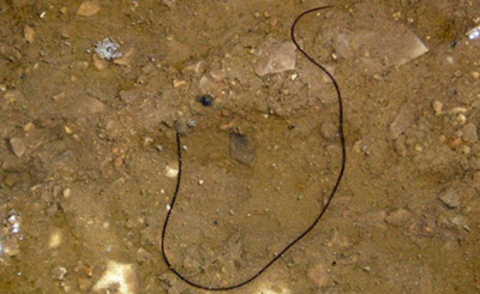Quick facts
- Horsehair or gordian worms are long, slender worms related to nematodes.
- When they are immature, they are parasites of insects, arthropods and other invertebrate animals.
- They are harmless to people in all stages of their lives.
- They are considered beneficial as they control other insects.
- They become a nuisance when found in swimming pools, water tanks or toilets.
How to identify horsehair worms
- Horsehair worms are long, measuring from several inches to over 14 inches.
- They are quite thin, ranging from 1/25 inch to 1/16 inch wide (1 mm to 1.5 mm) and are uniform in diameter from front to back.
- They vary in color from whitish to yellow/tan to brown/black.
- Horsehair worms are found on the ground or on plants, especially near water.
Behaviors
- Horsehair worms mate during spring, early summer or fall.
- Males coil around females in pools of fresh water or damp soil.
- It is common to see a number of worms to be intertwined, forming a loose ball during mating.
- Eggs are laid in a long, gelatinous string in fresh water.
- Once they hatch, immature horsehair worms try to infect a host.
- They can attack a wide variety of insects and related animals: grasshoppers, crickets, cockroaches, beetles, and katydids, as well as dragonflies, caddisflies, millipedes, centipedes, spiders, crustaceans, leeches, snails, slugs and other invertebrates.
Feeding
- It is not clear how immature horsehair worms infect hosts.
- When they infect their host, horsehair worms store up fats and food reserves.
- When the horsehair worm is mature and near water or damp soil, it emerges from its host.
- This process usually kills the host.
- Adults do not feed.
Where they live
- Horsehair worms are often seen in puddles and other pools of fresh water, swimming pools, water tanks and on plants.
- They are especially noticeable after rainfall.
- Horsehair worms may be found inside homes in toilets causing people to be concerned that it is a human parasite.
No control is necessary
Horsehair worms are harmless to people, pets and plants.
- They should be considered beneficial because they can be effective in controlling certain insects.
- No control is necessary for horsehair worms.
Reviewed in 2023



